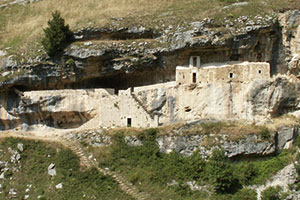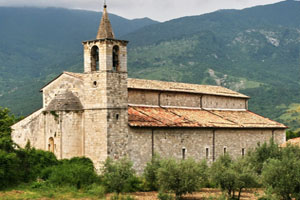
HERMITAGE OF SAN BARTOLOMEO IN LEGIO (EREMO DI SAN BARTOLOMEO IN LEGIO)

The hermitage
The Hermitage of San Bartolomeo is in the Majella National Park, between the small hamlets of Abbateggio and Roccamorice. It is a very impressive hermitage, placed on the rocky wall of the "Vallone dello Spirito" (Narrow Valley of the Spirit), crossed by the stream Capo La Vena.
The oratory of the hermitage is almost entirely hollowed out in the rock. Furthermore, we can find also a sixteenth-century altar with a niche, containing the nineteenth-century wooden statue representing the saint.
Each 25th of August, the hamlet of Roccamorice celebrates St. Bartholomew and on this occasion, its inhabitants walk in procession, bringing the statue of the saint from the Hermitage until the church of the village.
Near the stream, there is the Sorgente del Catenaccio (Spring of Catenaccio), whose name derives from the peculiar shape that reminds the iron lock of a door. According to folk tradition, its shape is due to the fact that during a torrid summer, a hermit flung the lock of the hermitage main door, given in to despair because of the lack of water. The strong impact of the lock left the print into the rock, from which flew miraculously a trickle of fresh and pure water that never stopped to flow until today.
History
The original nucleus of the hermitage dates back to the 6th century, on which in the same period, was added a chapel dedicated to San Bartolomeo, a cult introduced on the Majella by hermits, arrived from Sicily after the Arab occupation.
Pietro da Morrone, the future Pope Celestine V, brought it to its current dimension and appearance, then restored the hermitage around 1250.
Pietro da Morrone lived there around two years, and he left forcedly the Hermitage of Santo Spirito because of the increasing number of pilgrims. From 1274 to 1276, Pietro collected his thoughts in prayer, but his growing fame attracted even here thousands of believers, despite the rough and difficult access. The future pope decided so to move to the then impassable Orfento Valley, more precisely the Hermitage of San Giovanni.
Over the years, the Hermitage of San Bartolomeo was used as an annex to the Hermitage of Santo Spirito, placed upstream.
How to reach it
The most comfortable path to reach the hermitage is the road from Roccamorice to Blockhouse. Alter 4 kms from Roccamorice, follow the road signs to ‘Eremo di Santo Spirito’ and after 100 mts, on the right you will find the road sign to the ‘Eremo di San Bartolomeo’. Park your car and walk about half an hour to reach the hermitage.
A second possible path start from the ‘Valle Giumentina’. From our farm stay, follow the road signs to San Valentino-Caramanico and after few kilometers, on your left you will find the road sign to ‘Valle Giumentina-EcoMuseo del Paleolitico’ (Giumentina Valley, Echo Museum of the Palaeolithic). Turn left and once arrived at the visible EcoMuseo, if you do not drive an off-road vehicle or a special car for rough roads, it is advisable to park the car before the EcoMuseo. Walk on the path next to the Museum until the sign of the Eremo di San Bartolomeo.
Coordinates: 42° 10′ 55.46″ N, 14° 2′ 17.81″ E
For guided excursions to the Hermitage of San Bartolomeo visit the web-site Majellando.
CHIESA DI SAN TOMMASO (THE CHURCH OF St. THOMAS)

The church
The church of St. Thomas stands close to the village of Caramanico Terme and a legend narrates it was built in 45 After Christ, following the appearance of the Archangels Michael and Gabriel.
Some researchers suppose that the church actually stood on an ancient temple dedicated to Hercules, thanks to the find of small bronzes representing the go, just near the structure. Moreover, the crypt of the church keeps a spring water well, an element often associated with the rituals of the cult of Hercules.
Despite the many accidents, the church retains the original layout dating back to the late 12th, early 13th century. The facade of St Thomas has an end with broken gabled. In the main body, it opens the greater portal and the rosette, while in the wings we can see the smaller portals and the windows with different sizes and decorations. The central portal is particularly precious: palmettes, leaves and pinecones are carved in the capitals; In the jambs, a shoot among flowers, fruits, leaves and birds; In the lunette it is visible in red the preliminary drawing of the fresco that would have decorated it and that represents a Madonna with Child between two Saints.
Very interesting is the decoration of the architrave: in the middle, there is the benedictory Christ on the throne and sideways the figures of the apostles, similar in their faces and cloths. The motif of the side portals are simpler and we can see branches coming out from the jaws of animals. Only the right window on the façade is decorated with embossed columns and a luxuriant branch of leaves and cone pines, once again begot from two animals. In the middle of the façade, we find the rosette composed of ten columns arranged in radius and connected with each other by round arches.
The interior of the church shows a structure with one nave and two aisles, a raised presbytery, a semi-circular apse, and a covering with wooden trusses. The stone pillars divide spaces through round arches. Close to the presbytery, arches appear with a slightly acute profile and besides pillars, there are pilasters and semi-columns. The thin small column on the right, counters the solidity of pillars that according to the legend was put by angels as a worked miracle.
The bell tower on the right of the apse was built after the church, in the 18th century.
Some pillars have traces of frescoes. Interesting are the scenes of the Passion of Christ, representing the Deposition of Jesus from the Cross, the Burial of Christ and the Descent to the Limbo. According to stylistic comparisons, frescoes date back to the second half of the 13th century, in particular to the two decades between 1270 and 1290.
How to reach it
From our Farm stay, follow the road signs to Caramanico. The church is in the homonymous district of "San Tommaso", just a few kilometers before the village.
Coordinates: 42° 11′ 3.13″ N, 13° 58′ 22.39″ E



